
Logan Square is an official community area, historical neighborhood, and public square on the northwest side of the City of Chicago. The Logan Square community area is one of the 77 city-designated community areas established for planning purposes. The Logan Square neighborhood, located within the Logan Square community area, is centered on the public square that serves as its namesake, located at the three-way intersection of Milwaukee Avenue, Logan Boulevard and Kedzie Boulevard.

The Near South Side is a community area of Chicago, Illinois, United States, just south of the downtown central business district, the Loop. The Near South Side's boundaries are as follows: North—Roosevelt Road ; South—26th Street; West—Chicago River between Roosevelt and 18th Street, Clark Street between 18th Street and Cermak Road, Federal between Cermak Road and the Stevenson Expressway just south of 25th Street, and Clark Street again between the Stevenson and 26th Street; and East—Lake Michigan.

Douglas, on the South Side of Chicago, Illinois, is one of Chicago's 77 community areas. The neighborhood is named for Stephen A. Douglas, Illinois politician and Abraham Lincoln's political foe, whose estate included a tract of land given to the federal government. This tract later was developed for use as the Civil War Union training and prison camp, Camp Douglas, located in what is now the eastern portion of the Douglas neighborhood. Douglas gave that part of his estate at Cottage Grove and 35th to the Old University of Chicago. The Chicago 2016 Olympic bid planned for the Olympic Village to be constructed on a 37-acre (15 ha) truck parking lot, south of McCormick Place, that is mostly in the Douglas community area and partly in the Near South Side.

Chatham is one of the 77 community areas of the city of Chicago, Illinois. It is located on the city's South Side. It includes the neighborhoods of Chatham-Avalon, Chatham Club, Chesterfield, East Chatham, West Chatham and the northern portion of West Chesterfield. Its residents are predominantly African American, and it is home to former Senator Roland Burris. Housing many city employees and other officials, Chatham has been a central area for Chicago's middle-class African Americans since the late 1950s.
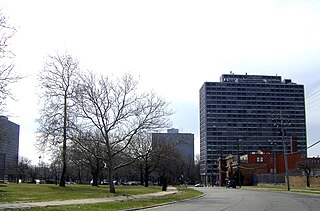
Lafayette Park is an neighborhood located east of Downtown Detroit. It contains a residential area of some 4,900 people and covers 0.07 sq mi.

The East Jefferson Avenue Residential District in Detroit, Michigan, includes the Thematic Resource (TR) in the multiple property submission to the National Register of Historic Places which was approved on October 9, 1985. The structures are single-family and multiple-unit residential buildings with construction dates spanning nearly a century, from 1835 to 1931. The area is located on the lower east side of the city.

Rosenwald Court Apartments is a large apartment building located in the Bronzeville neighborhood of the South Side of Chicago, Illinois. It is located at East 47th Street and South Michigan Avenue, just one block east of the former Chicago Housing Authority's Robert Taylor Homes site. In total, the building is made up of 421 apartments, a large landscaped courtyard, and retail space at street level. It was originally built as non-governmental subsidized housing and is considered to be among the earliest mixed-use housing developments.

Prairie Avenue is a north–south street on the South Side of Chicago, which historically extended from 16th Street in the Near South Side to the city's southern limits and beyond. The street has a rich history from its origins as a major trail for horseback riders and carriages. During the last three decades of the 19th century, a six-block section of the street served as the residence of many of Chicago's elite families and an additional four-block section was also known for grand homes. The upper six-block section includes part of the historic Prairie Avenue District, which was declared a Chicago Landmark and added to the National Register of Historic Places.

The Robbins Park Historic District is a set of three hundred and sixty-eight buildings in Hinsdale, Illinois. Two hundred and thirty-two of these builds contribute to its historical value. The district was platted by William Robbins in the 1860s and 1870s following the completion of the Chicago, Burlington and Quincy Railroad. Wealthy entrepreneurs moved to the district beginning in the 1890s due to its natural beauty and proximity to major golf resorts. The district was added to the National Register of Historic Places in 2008 and features two houses previously honored by the register.

The Cottage Home Historic District is a historic district and neighborhood located on the near east side of Indianapolis, Indiana. A small portion of Cottage Home is listed on the National Register of Historic Places while a larger area is listed on the state and local levels. Known for its preponderance of "cottage-style" homes built with strong Victorian influences, Cottage Home has historically been a working class neighborhood. Numerous industrial buildings are also scattered throughout the district, providing a base of economic activity. Today, however, many of these buildings are vacant, providing a special challenge to preservation and urban renewal efforts.

Julia C. Lathrop Homes is a Chicago Housing Authority (CHA) public housing project located along the line between the Lincoln Park and North Center neighborhoods on the north side of Chicago, Illinois, United States. It is bordered by the neighborhoods of Bucktown and Roscoe Village. Completed in 1938 by the Public Works Administration, Lathrop Homes was one of the first Chicago public housing projects. Lathrop Homes was placed on the National Register of Historic Places in 2012 and is currently undergoing restoration. Lathrop Homes consists of two-story brick row houses and three- and four-story apartment buildings separated by landscaped courtyards and linked by small archways in a campus-like arrangement. There are a total of 925 units on 35.5 acres of land.
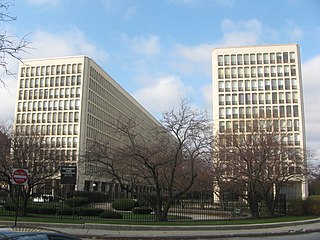
The University Apartments, also known as the University Park Condominiums, are a pair of ten-story towers in Chicago, Illinois designed by I. M. Pei and Araldo Cossutta. The project was part of a city initiative to revitalize the residential development in Hyde Park just north of the University of Chicago. Within the Hyde Park neighborhood, they are colloquially known as "Monoxide Island."

Parkway Gardens Apartment Homes is a 694-unit privately-owned apartment complex located on the border of Woodlawn and Washington Park. Chicago’s Woodlawn and Washington Park community areas are located on the South Side of Chicago, Illinois. The complex was built from 1950 to 1955; architect Henry K. Holsman, who planned several of Chicago's affordable housing developments, designed the Modernist buildings.

Hilliard Towers Apartments, formerly known as the Raymond Hilliard Homes CHA housing project, is a residential high-rise development in the near South Side of Chicago, Illinois. It was designed by Bertrand Goldberg and is bounded by Clark Street, State Street, Cullerton Street, and Cermak Road. In 1999, it was placed on the National Register of Historic Places as the Raymond M. Hilliard Center Historic District. The development was named for Raymond Marcellus Hilliard, who was the director of the Cook County Department of Welfare from 1954 until his death in 1966.
The Duplex at 22-26 Johnson Street is a historic multiunit residential building in Burlington, Vermont. Built about 1888, it is a good local example of vernacular Queen Anne Victorian architecture, built as worker housing in the growing city. It was listed on the National Register of Historic Places in 2012.

The West Chatham Bungalow Historic District is a residential historic district in the Chatham neighborhood of Chicago, Illinois. The district includes 283 Chicago bungalows built between 1913 and 1930 along with a smaller number of other residential buildings. As Chicago grew in the early 20th century and homeownership became more accessible, the bungalow arose as a popular and affordable house design, and tens of thousands of them were built in the city. Chatham, an outlying neighborhood on the city's South Side, benefited from this housing boom, as its transit connections made the area an attractive choice for new housing. The West Chatham bungalows are all brick and feature similar designs, giving the neighborhood a uniform appearance; however, decorative features such as patterned brickwork provide diversity among the homes.
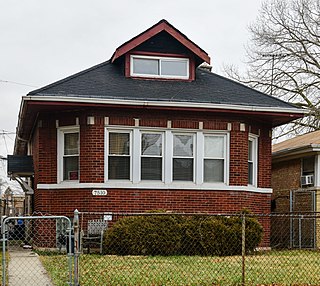
The Auburn Gresham Bungalow Historic District is a residential historic district in the Auburn Gresham neighborhood of Chicago, Illinois. The district includes 264 Chicago bungalows built from 1918 to 1932 along with a variety of other residential buildings. Homeownership became more attainable for working-class Chicagoans in the early twentieth century, and affordable bungalows played a key role in this pattern, with tens of thousands of the homes built in the city. Auburn Gresham, a South Side neighborhood with railroad access and little prior development, was one of the many parts of the city developed during the bungalow boom. While thirty-two different architects designed homes in the district, the bungalows are still relatively similar, as the uniform building design was a major factor in their affordability; however, elements such as color and brickwork distinguish the individual homes.
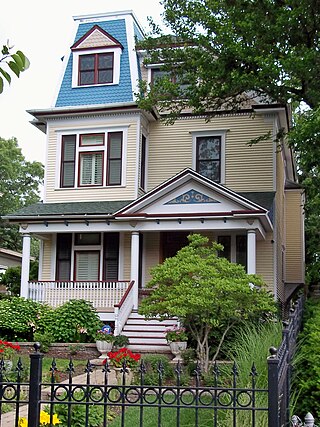
The Sheridan Park Historic District is a residential historic district in the Uptown neighborhood of Chicago, Illinois. Developed between 1891 and 1929, the district is a collection of single-family homes, small apartment buildings, and a handful of larger apartment hotels. The homes were built early in the district's development, with nearly all of them completed by 1910; at the time, the district was planned as a spacious suburb and categorized with North Shore communities. The apartments were all built in the twentieth century as the dense city core of Chicago expanded into the district. The district includes a large collection of six-flat apartments in particular; small apartments such as these, which were only three stories tall, fit neatly among the single-family houses of the original neighborhood.

The Schorsch Irving Park Gardens Historic District is a residential historic district in the Dunning neighborhood of Chicago, Illinois. The district includes 255 buildings, all but three of which are Chicago bungalows. In the early twentieth century, tens of thousands of Chicago bungalows were built in the city; as homeownership became more accessible to working-class Chicagoans, demand for housing increased, and bungalows were an affordable way of meeting this demand due to their relatively uniform design. The bungalows in the district were largely built either between 1917 and 1918 or between 1922 and 1926. Unlike Chicago's other bungalow-dominated neighborhoods, which often had several different developers, developer Albert J. Schorsch built every bungalow in the district, and architech Ernest N. Braucher designed all of them. To add diversity to a neighborhood made up of only one style of house, the two men varied the homes' roof shapes, colors, and dormers.
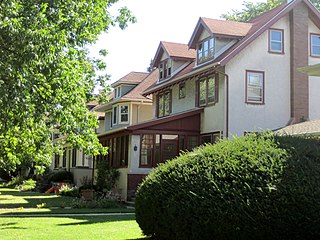
The Gunderson Historic District is a residential historic district in southern Oak Park, Illinois. The district encompasses 230 residential buildings built between 1906 and 1920, the vast majority of which are single-family homes. The development was the second of two built in Oak Park by S.T. Gunderson and Sons, a housing company which mainly worked in Oak Park and the West Side of Chicago. The firm commissioned architect Frank DeMoney to design their Oak Park houses; most of his designs used the American Foursquare style, a simple style which could be executed affordably. DeMoney differentiated the houses by applying elements of other contemporary architectural styles, such as Arts and Crafts, Colonial Revival, or Prairie School. The uniform design and layout of its homes made the district an early example of tract housing, which would become much more widespread later in the twentieth century.





















